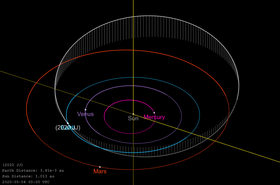2020 JJ
| 2020 JJ | |
|---|---|

| |
2020 JJの軌道。各惑星と2020 JJの位置は2020年5月4日(協定世界時)時点のもの。
| |
| 仮符号・別名 | C2QQFV2[1] |
| 分類 | 小惑星 地球近傍天体[2][3] |
| 軌道の種類 | アポロ群[2][3] |
| 発見 | |
| 発見日 | 2020年5月4日[3] |
| 発見者 | レモン山サーベイ[3] |
| 発見場所 | レモン山天文台 |
| 軌道要素と性質 元期:JD 2,459,000.5(2020年5月31.0日)[2] | |
| 軌道長半径 (a) | 1.507 au[2] |
| 近日点距離 (q) | 0.871 au[2] |
| 遠日点距離 (Q) | 2.143 au[2] |
| 離心率 (e) | 0.422[2] |
| 公転周期 (P) | 1.85 年[2] (675.489 日[2]) |
| 軌道傾斜角 (i) | 11.192°[2] |
| 近日点引数 (ω) | 237.332°[2] |
| 昇交点黄経 (Ω) | 44.188°[2] |
| 平均近点角 (M) | 350.734°[2] |
| 前回近日点通過 | 2018年8月頃 |
| 次回近日点通過 | JD 2,459,017.887[2] (2020年6月17日) |
| 物理的性質 | |
| 直径 | 2.7 - 6 m[4][5] |
| 絶対等級 (H) | 29.966 ± 0.092[2] 30.0[3] |
| ■Template (■ノート ■解説) ■Project | |
2020 JJは、2020年に発見されたアポロ群に属する小惑星の一つである[2][3]。絶対等級は約30等級と極めて暗く、直径が2.7~6 mしかないかなり微小な天体であると考えられている[4][5]。
特徴
[編集]
2020 JJは軌道離心率0.422の潰れた楕円軌道を1.85年かけて公転しており、近日点では地球軌道よりも太陽に近づき、遠日点では火星軌道よりも外側まで遠ざかる[2][3]。アポロ群に分類される地球近傍天体(NEO)で、地球との最小交差距離(Earth MOID)はわずか526 km(3.52×10−6 au)しかない[2]。
2020 JJは、2020年5月4日の5時53分から6時16分(いずれもUTC)までにレモン山天文台で行われているレモン山サーベイによって撮影された画像から検出され、発見当初は「C2QQFV2」という暫定名称で呼ばれていた[1]。その後すぐに行われた分析により、2020 JJが地球のすぐ傍にまで接近していることが判明し、その後6時間以内に地球に衝突する確率が5%ほどあると分析されたが[1]、最終的に2020 JJは、同日12時5分前後(UTC)に南太平洋の上空約7,000 km(地球の中心から13,400 km)を通過していったとみられている[1][4][5]。
仮に2020 JJが地球の大気圏に突入したとしても、大気圏内でほぼ燃え尽きていたと考えられているが、2020 JJはこれまでで6番目の近さにまで地球に接近した小惑星で[4][5]、同等の近さにまで小惑星が接近したのは2019年10月31日に地表から6,200 kmにまで接近した2019 UN13以来である[5][6]。
出典
[編集]- ^ a b c d “An even closer unexpected approach”. ESA (2020年5月6日). 2020年5月10日閲覧。
- ^ a b c d e f g h i j k l m n o p q r “JPL Small-Body Database Browser: 2020 JJ”. JPL Small-Body Database. Jet Propulsion Laboratory. 2020年5月10日閲覧。 (2020-05-04 last obs.)
- ^ a b c d e f g “2020 JJ”. Minor Planet Center. 2020年5月10日閲覧。
- ^ a b c d Eric Mack (2020年5月5日). “Asteroid sneaks past satellites in one of the closest flybys on record”. CNET. 2020年5月10日閲覧。
- ^ a b c d e Teo Blašković (2020年5月4日). “Asteroid 2020 JJ flew past Earth at just 0.03 LD on May 4 -- the closest of the year and 6th closest on record”. The Watchers. 2020年5月10日閲覧。
- ^ Eric Mack (2019年10月31日). “Spooky Halloween asteroid flyby one of the closest near misses ever seen”. CNET. 2020年5月10日閲覧。
関連項目
[編集]2020年に発見された天体 | |
|---|---|
| 主な太陽系外惑星 | |
| 主な小惑星 | |
| 主な衛星 |
|
| 主な彗星 | |
| その他主な発見 |
|
Text is available under the CC BY-SA 4.0 license; additional terms may apply.
Images, videos and audio are available under their respective licenses.
